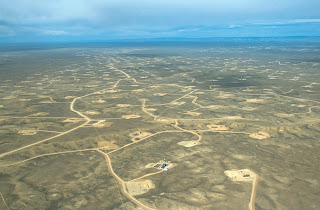
Tight sands natural gas development in the Jonah field of Wyoming's Upper Green River Basin. Photograph courtesy Peter Aengst, The Wilderness Society, and Lighthawk.
The rampant development of prime antelope and mule deer winter range in Wyoming during the Bush Administration triggered a close look at the impact from natural gas developments. The claim that the impact is limited to the area of the ground disturbance from the road construction and wells, or towers in the case of wind energy, is erroneous. The actual ecological footprint is much larger and impacts to wildlife reveal that these developments can be likened to a spider web. While the area of each strand from the web is relatively small, the entire area within the web is affected. For migrating elk, antelope, and mule deer, these wind developments can be impassable, severing access to critical habitat. For bats and birds they can be a death trap. Consider the location of the Craig Mountain proposed wind energy development near Union, Oregon. Elk migrate from the Wallowas and Oregon’s largest Wilderness Area across Craig Mountain and down into the largest wetland left in northeast Oregon, Ladd Marsh. I am consistently in awe at the amount and diversity of wildlife thriving in and near Ladd Marsh. This vital wildlife corridor is threatened by a proposal that would spread wind towers all across Craig Mountain and beyond. Pre and post-monitoring of the Elkhorn wind development near Telocaset indicates that elk and mule deer have been displaced. I have heard reports that several Golden Eagles have been killed in the Elkhorn turbines.
Nearly everyone agrees that wind energy development has a place in Oregon’s future energy portfolio. However, some parts of Oregon are just too beautiful, too important for wildlife, too precious to be fragmented and marred by massive energy developments. Generations of Oregonians have worked to develop a meaningful conservation legacy here in Oregon. Sacrificing this hard-earned legacy in the name of "renewable energy" is a false tradeoff.
David Mildrexler
Ecosystem Conservation Cooordinator

No comments:
Post a Comment